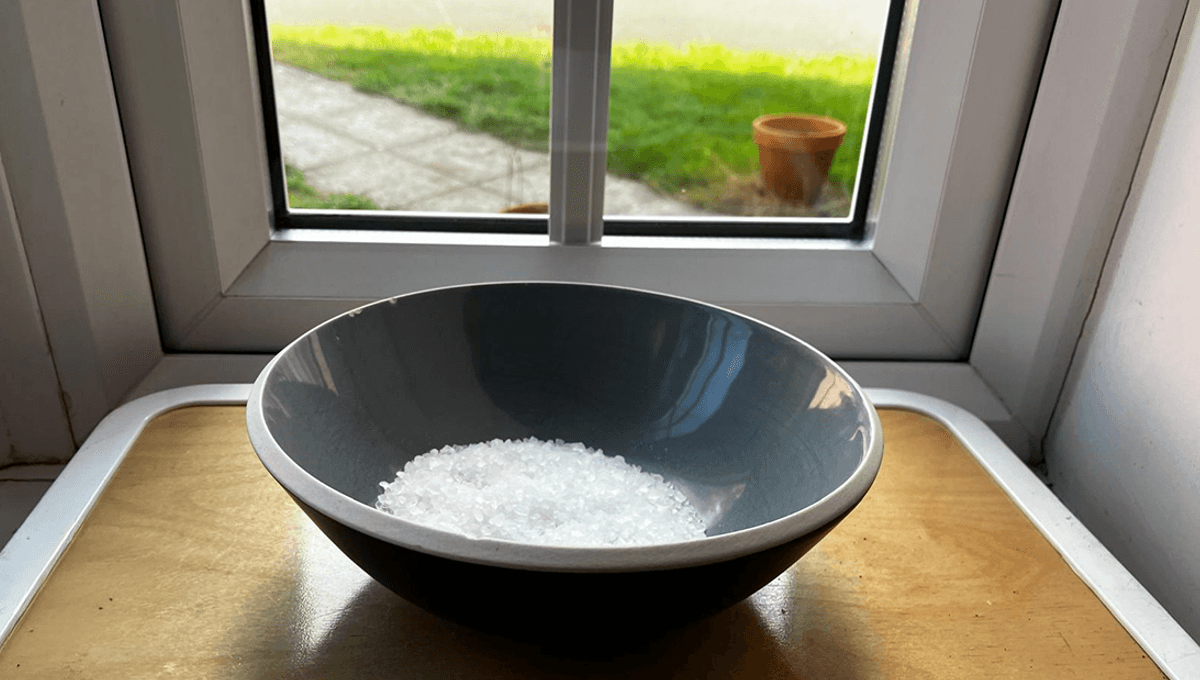
People in the United Kingdom are once again being urged to place bowls of salt in their windows this winter, in an attempt to prevent damp conditions and mold. But is that really good advice?
When water vapor in your home or vehicle hits a cold surface, such as your windows, it changes back into a liquid state, creating condensation.
“Condensation is not a matter of one particular temperature but of a difference between two temperatures: the air temperature and the dewpoint temperature,” the National Oceanic and Atmospheric Administration (NOAA) explains. “The dew point is the temperature at which dew can form – it is the point at which air becomes saturated and can not hold any more water vapor. Any additional cooling causes water vapor to condense.”
You can do all sorts to deal with condensation, which can lead to problems like damp and mold, and can damage your window frames. In a car, you can blast the windows with air to prevent condensation, replace the air with less humid air from outside, and use the air conditioning.
“The most efficient way to remove moisture from the air is to use the vehicle’s air conditioning system,” Toyota explains. “This system draws air from the cabin through an evaporator, which causes moisture in the air to condensate in a controlled way and drain out of the vehicle.”
In your home, condensation buildup can be a little trickier to deal with, but the principles are the same.
One way that has been suggested to deal with condensation is to place a bowl of salt near your window during the colder months.
“Salt has the ability to naturally absorb moisture from the air and essentially dries it out so that when it does come in contact with the glass, there are less droplets of condensation that will form,” Andy Ellis, home and garden expert at Posh.co.uk said in a statement seen by the Mirror.
“It’s a really easy trick that requires no effort at all. Simply fill a shallow bowl or a small jar with some salt – this can be table salt or rock salt. The amount you use will vary depending on the size of the window you’re placing it next to. Of course, generally speaking, the larger the window the more salt you’ll need, though usually one small bowl should be fine.”
“Regular condensation build-up isn’t just unsightly – it can become a breeding ground for mould, which poses risks to household health,” Lottomart added to Wales Online. “The method is really easy to follow. All you need to do is fill a small bowl or jar with table salt and place it on your windowsill. Once the salt clumps together, that’s your sign to replace it with a fresh batch to keep it working effectively.”
So should you start doing this? Well, it is true that salt can remove moisture from the air, but there are caveats.
“A particular example of hygroscopic behavior is deliquescence which is exhibited by many water-soluble solids, including inorganic salts (e.g., calcium chloride),” chemical engineer John Francis Richardson explained on Thermopedia.
“At a given temperature, the vapor pressure of a saturated salt solution will be lower than that of pure water and, if it is less than the partial pressure in the atmosphere, moisture will be transferred to the surface of the solids, part of which will dissolve to form a saturated solution. When all the solids have dissolved, the process will continue until the partial pressure of the now unsaturated solution equals that in the atmosphere. In some cases, the formation of a hydrate or higher hydrate of the salt may precede the formation of a liquid phase. Liquids (e.g., sulfuric acid) may also be deliquescent.”
However, it is unclear that this will have much of an effect, especially compared to other methods of preventing condensation build up. This is because salt only begins to absorb water vapor at relatively high humidity.
“At up to 74 percent relative humidity and 20°C [68°F], salt does not absorb any appreciable quantities of water vapor,” the German Transport Information Service explains. “The critical water content of sodium chloride (NaCl) is 0.5 percent at 74 percent relative humidity, which is the flow moisture point at which salt begins readily to absorb water vapor, and increases such that, at 75 percent relative humidity, the salt dissolves.”
Houses in the UK are generally less humid than this, tending to be between 30 and 60 percent humidity, though especially humid houses can go above 70 percent. Different areas of the house can have different humidity levels (think bathrooms or kitchens) so salt may help a little with the situation.
However, to really deal with the problem, like in your vehicle, ventilation is key. In houses, you can use vents often built into windows, or simply open them a crack to deal with the moisture. As well as letting the more humid air out, airflow helps to prevent water vapor from building up on the cold surface, preventing you from needing to put out little bowls of salt by the windows every morning, like some offering to the god of high blood pressure.
Source Link: People Are Being Urged To Put Bowls Of Salt In Their Window This Autumn And Winter, But Does It Work?